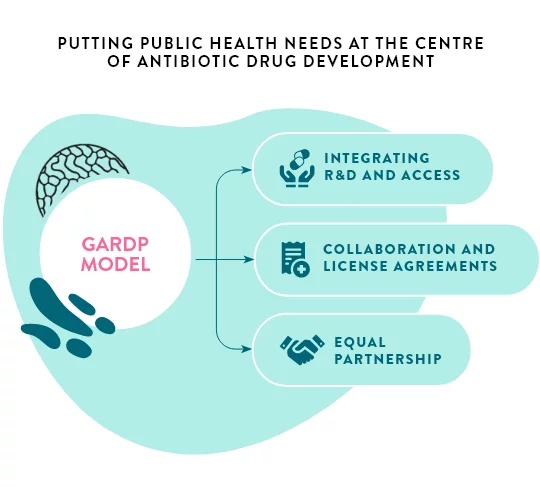GARDP Strategy
2024-2028
Putting public health needs at the centre of antibiotic drug development
Putting public health needs at the centre of antibiotic drug development
By 2028, we aim to demonstrate how GARDP’s unique antibiotic R&D partnership model can help to address the global AMR public health failure by enabling the right antibiotic treatments to be developed and made available to people who need them.
GARDP’s unique antibiotic R&D
partnership model



Maximizing impact
To significantly reduce mortality and morbidity related to drug resistance around the world, GARDP has developed a disease area strategy based on three criteria.
GARDP prioritizes serious bacterial infections and sepsis (including neonatal sepsis) and sexually transmitted infections (with a focus on gonorrhoea), and targets WHO priority pathogens that are responsible for particularly deadly and debilitating drug-resistant infections. GARDP also concentrates its efforts on populations who are disproportionately affected by drug resistance—like newborns, children and women, particularly in low- and middle-income countries.

GARDP’s expanded portfolio 2024-2028
GARDP’s expanded portfolio 2024-2028
GARDP is working towards its ambitious goal to deliver five new treatments by 2025. Its portfolio now includes approved and investigational treatments for serious bacterial infections and sepsis in adults, children and newborns, as well as drug-resistant gonorrhoea.
With critical support from our funders, we will potentially expand our portfolio during the period 2024-2028 with four new projects that align with our disease area strategy. GARDP will also consider any new priorities identified by WHO and related areas such as antifungal resistance.
Funding need: €220 million
For the period 2024–2028, GARDP is seeking €220 million to continue addressing the immediate public health needs for antibiotics, while working towards the creation of an ecosystem of antibiotic research, development and access for the world’s future antibiotic needs.



